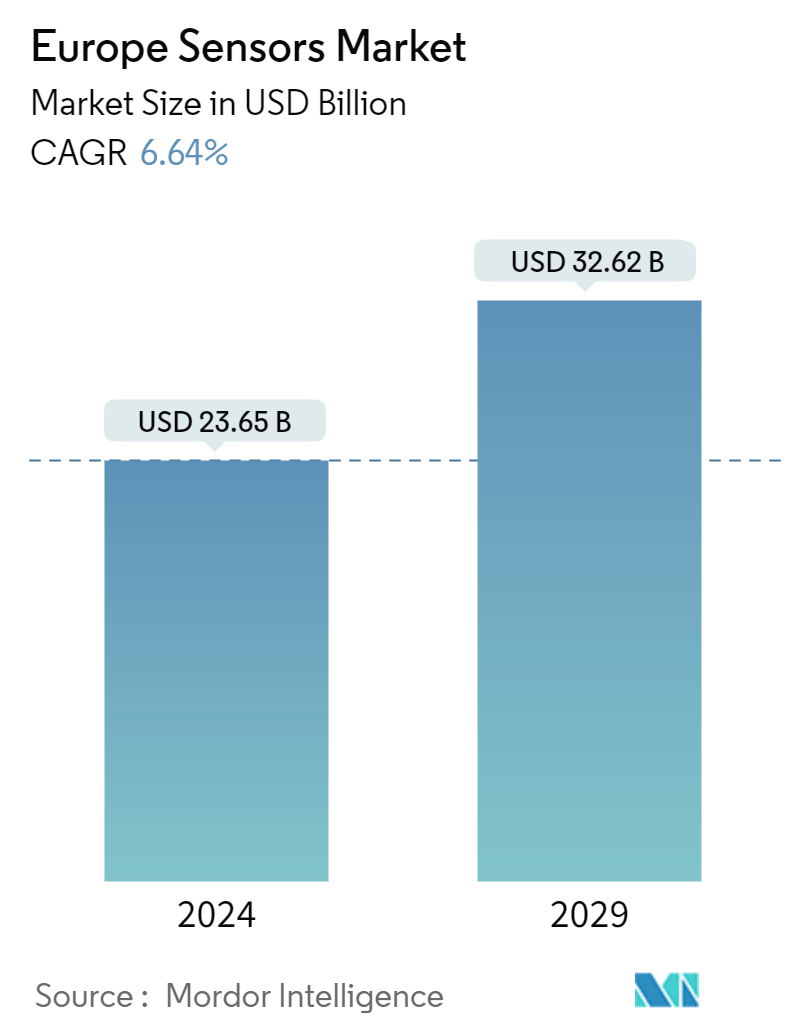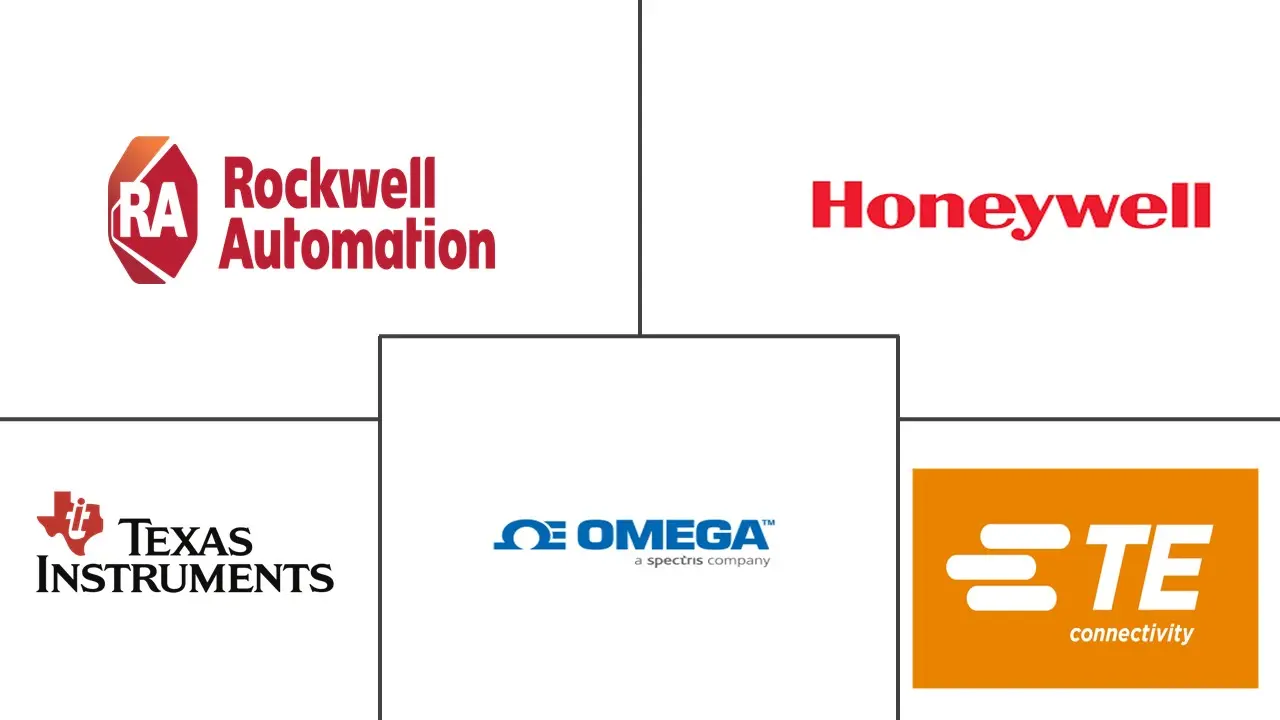Market Size of Europe Sensors Industry

| Study Period | 2019 - 2029 |
| Base Year For Estimation | 2023 |
| Market Size (2024) | USD 23.65 Billion |
| Market Size (2029) | USD 32.62 Billion |
| CAGR (2024 - 2029) | 6.64 % |
| Market Concentration | Medium |
Major Players
*Disclaimer: Major Players sorted in no particular order |
Europe Sensors Market Analysis
The Europe Sensors Market size is estimated at USD 23.65 billion in 2024, and is expected to reach USD 32.62 billion by 2029, growing at a CAGR of 6.64% during the forecast period (2024-2029).
Demand for intelligent sensor technology is rapidly expanding, from navigation systems in smartphones to driver-assistance systems. Sensors play an increasingly crucial role in winning the technology. Megatrends like the Internet of Things (IoT), wearable systems for health monitoring, and vehicle automation are significant drivers behind the growing demand for sensors.
- In the European sensor market, innovations in sectors like healthcare, automotive, defense and aerospace, and consumer electronics are said to be responsible for the growth. Another factor propelling the market is several government investments and initiatives to improve semiconductor production capabilities.
- In May 2024, Dexcom launched the Dexcom ONE+ continuous glucose monitor (CGM), in the UK. Drawing on insights from both users and healthcare experts, Dexcom has fine-tuned its established sensor design for the ONE+. Notably, this iteration features the advanced G7 sensor, a significant upgrade from its predecessor, which relied on the G6 sensor.
- However, high initial costs and operational concerns are the major factors anticipated to restrain the market's growth over the forecast period. Further, high-quality raw materials are vital for manufacturers as an essential part of producing superior sensors. Metals and alloys used in manufacturing include platinum, copper, silicon, tungsten, nickel, and alloys, which are further categorized into type-K, type-M, type-E, and type-J. Fluctuations in prices and supply of raw materials could also cause hindrances in the growth of the sensors market.
- The UK's Department for Science, Innovation, and Technology unveiled the National Semiconductor Strategy, committing to invest GBP 1 billion over the next decade. This investment aims to enhance infrastructure accessibility, bolster research and development efforts, and foster increased international collaboration, with an initial allocation of up to GBP 200 million earmarked for the years 2023-2025.
Europe Sensors Industry Segmentation
A sensor detects and responds to the inputs from the physical environment. A typical input could be pressure, light, heat, motion, and moisture, among many others.
The European sensor market is segmented by parameters measured (temperature, pressure, level, flow, proximity, environmental, chemical, inertial, magnetic, vibration and other parameters measured), mode of operation (optical, electrical resistance, biosensors, piezoresistive, image, capacitive, piezoelectric, lidar, radar, and other modes of operation), end-user industry (automotive, consumer electronics (smartphones, tablets, laptops, and computers, wearable devices, smart appliances or devices, and other consumer electronics), energy, industrial and other, medical and wellness, construction, agriculture and mining, aerospace, and defense), and country (United Kingdom, France, Germany, and Other European Countries). The market sizes and forecasts are provided in terms of value (USD) for all the above segments.
| By Parameters Measured | |
| Temperature | |
| Pessure | |
| Level | |
| Flow | |
| Proximity | |
| Environmental | |
| Chemical | |
| Inertial | |
| Magnetic | |
| Vibration | |
| Other Parameters Measured |
| By Mode of Operations | |
| Optical | |
| Electrical Resistance | |
| Biosenser | |
| Piezoresistive | |
| Image | |
| Capacitive | |
| Piezoelectric | |
| LiDAR | |
| Radar | |
| Other Modes of Operation |
| By End-user Industry | |||||||
| Automotive | |||||||
| |||||||
| Energy | |||||||
| Industrial and Other | |||||||
| Medical and Wellness | |||||||
| Construction, Agriculture, and Mining | |||||||
| Aerospace | |||||||
| Defense |
| By Country | |
| United Kingdom | |
| Germany | |
| France |
Europe Sensors Market Size Summary
The European sensors market is poised for significant growth, driven by the increasing demand for intelligent sensor technologies across various sectors. Key industries such as healthcare, automotive, defense, aerospace, and consumer electronics are contributing to this expansion. The rise of megatrends like the Internet of Things (IoT), wearable health monitoring systems, and vehicle automation are pivotal in boosting sensor demand. Government initiatives and investments, particularly in semiconductor production capabilities, are further propelling market growth. However, challenges such as high initial costs, operational concerns, and fluctuations in raw material prices pose potential restraints to the market's expansion.
In the automotive sector, the demand for sensors is fueled by the need for safer and more efficient vehicles, with sensors playing a crucial role in monitoring various vehicle parameters. The push towards electric vehicles and stringent government regulations in Europe are expected to further increase sensor requirements. Additionally, the growing popularity of smart consumer electronics and IoT devices is opening new application opportunities for sensors. The market is moderately fragmented, with key players like Honeywell, Rockwell, Siemens, and Infineon leading the charge. Recent innovations, such as AI Virtual Smart Sensors and advanced NOx sensors, highlight the ongoing advancements and competitive dynamics within the European sensors market.
Europe Sensors Market Size - Table of Contents
-
1. MARKET INSIGHTS
-
1.1 Market Overview
-
1.2 Industry Value Chain Analysis
-
1.3 Industry Attractiveness - Porter's Five Forces Analysis
-
1.3.1 Bargaining Power of Suppliers
-
1.3.2 Bargaining Power of Consumers
-
1.3.3 Threat of New Entrants
-
1.3.4 Threat of Substitute Products
-
1.3.5 Intensity of Competitive Rivalry
-
-
1.4 Impact of Macroeconomic Factors on the Market
-
-
2. MARKET SEGMENTATION
-
2.1 By Parameters Measured
-
2.1.1 Temperature
-
2.1.2 Pessure
-
2.1.3 Level
-
2.1.4 Flow
-
2.1.5 Proximity
-
2.1.6 Environmental
-
2.1.7 Chemical
-
2.1.8 Inertial
-
2.1.9 Magnetic
-
2.1.10 Vibration
-
2.1.11 Other Parameters Measured
-
-
2.2 By Mode of Operations
-
2.2.1 Optical
-
2.2.2 Electrical Resistance
-
2.2.3 Biosenser
-
2.2.4 Piezoresistive
-
2.2.5 Image
-
2.2.6 Capacitive
-
2.2.7 Piezoelectric
-
2.2.8 LiDAR
-
2.2.9 Radar
-
2.2.10 Other Modes of Operation
-
-
2.3 By End-user Industry
-
2.3.1 Automotive
-
2.3.2 Consumer Electronics
-
2.3.2.1 Smartphones
-
2.3.2.2 Tablets, Laptops, and Computers
-
2.3.2.3 Wearable Devices
-
2.3.2.4 Smart Appliances or Devices
-
2.3.2.5 Other Consumer Electronics
-
-
2.3.3 Energy
-
2.3.4 Industrial and Other
-
2.3.5 Medical and Wellness
-
2.3.6 Construction, Agriculture, and Mining
-
2.3.7 Aerospace
-
2.3.8 Defense
-
-
2.4 By Country
-
2.4.1 United Kingdom
-
2.4.2 Germany
-
2.4.3 France
-
-
Europe Sensors Market Size FAQs
How big is the Europe Sensors Market?
The Europe Sensors Market size is expected to reach USD 23.65 billion in 2024 and grow at a CAGR of 6.64% to reach USD 32.62 billion by 2029.
What is the current Europe Sensors Market size?
In 2024, the Europe Sensors Market size is expected to reach USD 23.65 billion.

